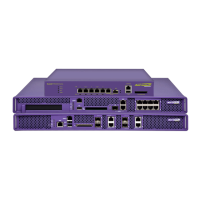Controller Services
Summit WM3000 Series Controller System Reference Guide264
3 Refer to the following information (as displayed within the NTP Neighbor tab) to assess whether an
existing neighbor configuration can be used as is, if an existing configuration requires modification
or a new configuration is required.
4 Select an existing neighbor and click the Edit button to modify the existing peer or server
designation, IP address, version, authentication key ID and preferred source designation.
5 Select an existing entry and click the Delete button to remove it from the table.
IP Address/Hostname
Displays the numeric IP address of the resource (peer or server) providing
controller SNTP resources. Ensure the server is on the same subnet as
the controller to provide SNTP support.
Neighbor Type
Displays whether the NTP resource is a Peer (another associated peer
device capable of SNTP support) or a Server (a dedicated NTP server
resource). This designation is made when adding or editing an NTP
neighbor.
Key ID
Displays whether AutoKey Authentication or Symmetric Key
Authentication is used to secure the interaction between the controller
and its NTP resource. This designation is made when adding or editing
an NTP neighbor.
Preferred Source
Displays whether this NTP resource is a preferred NTP resource. Preferred
sources (those with a checkmark) are contacted before non-preferred
resources. There can be more than one preferred source.
NTP Version
Displays a NTP version between 1 and 4. Currently version three and four
implementations of NTP are available. The latest version is NTPv4, but
the official Internet standard is NTPv3.

